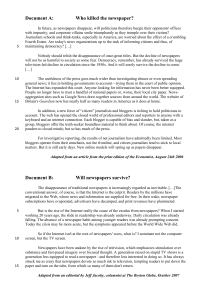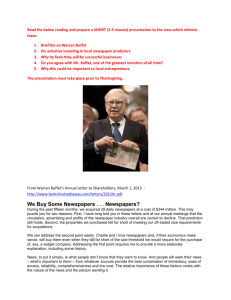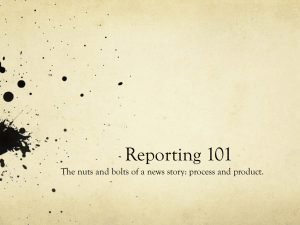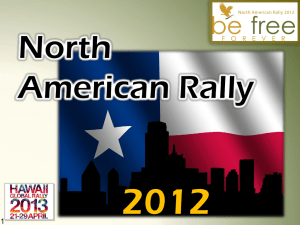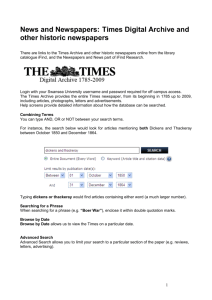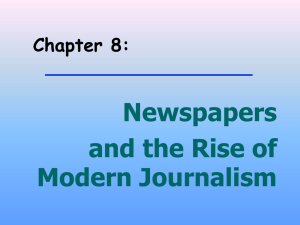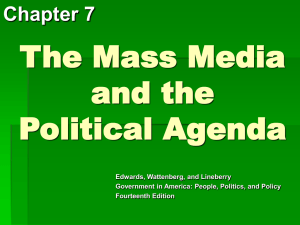Newspapers - Saving Community Journalism
advertisement
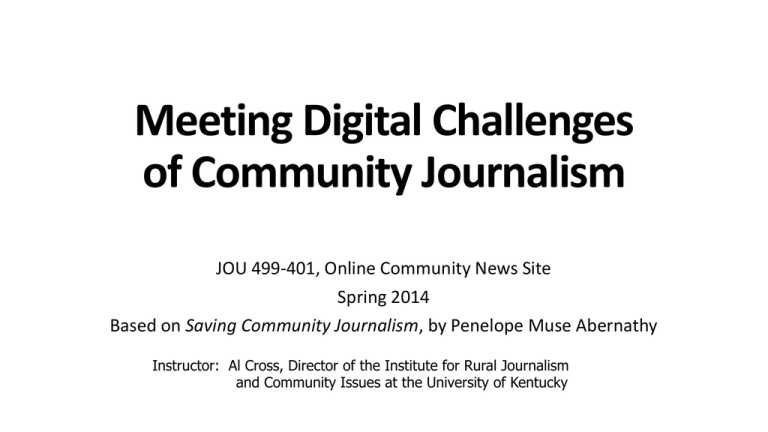
Meeting Digital Challenges of Community Journalism JOU 499-401, Online Community News Site Spring 2014 Based on Saving Community Journalism, by Penelope Muse Abernathy Instructor: Al Cross, Director of the Institute for Rural Journalism and Community Issues at the University of Kentucky Newspapers differ from most other businesses • BUSINESS MODEL: Newspapers get a small share of revenue from selling a product directly to customers, not enough to cover the cost of producing the product; instead, they sell access to customers, through advertising • HISTORIC MISSION: Informing and educating the public, a service necessary for the proper functioning of democracy, and enshrined in the First Amendment to the U.S. Constitution. The only profession mentioned in the Constitution, other than law and government positions, is “the press.” WHY? To act as a watchdog on government and help citizens cast informed votes, making democracy work. Newspapers differ from most other businesses • WATCHDOG FUNCTION: Alex Jones of Harvard, who went from a small-town newspaper family in East Tennessee to The New York Times, estimates that 85 percent of the enterprise journalism that causes major changes in public policy comes from newspapers • ACCOUNTABILITY JOURNALISM: Two main types: Beat reporting, including meetings of public agencies, which are a window to see issues; and investigative and interpretive reporting on “quality of life issues,” from government corruption to environment to health • SMALL PAPERS CAN DO BIG THINGS: Some small, rural papers have won Pulitzer Prizes and other awards for being strong watchdogs Newspapers are undergoing creative destruction • Newspaper advertising revenue has fallen to the level of 1950, mainly from loss of classifieds to Craigslist and other online outlets, and stock prices of newspaper companies are 1/5 the level of 2006 • Major metropolitan newspapers have cut back on circulation and news coverage in areas beyond their metropolitan areas, putting more responsibility on smaller newspapers to be local watchdogs • That’s one reason the Institute for Rural Journalism and Community Issues was created, to help rural journalists define the public agenda in their communities, through strong reporting and commentary – especially on issues that affect the community but come at it from afar and have few reliable, local sources (example: the coalfields) Newspapers’ community functions in the digital era • Agenda setting is more important in the digital age, when people have so many sources of information they are overloaded; when a newspaper uncovers facts and takes a stand, it can influence policy • Newspapers can also encourage community growth and commerce; in the digital era, they must look for new ways to do it; some get into the website construction business • They can also foster a sense of geographic community, including commonalities with nearby communities citizens may not think of as their own; this can also help a newspaper maintain or even expand its market What makes a newspaper a community paper? • AUDIENCE, traditionally measured by print circulation Upper limit has been defined as low as 15,000, as high as 50,000 Your instructor thinks 30,000 is about right • CONTENT: If a newspaper emphasizes local news and treats state, national and international news as secondary, it’s a community paper • A NEW DEFINITION: The author of your reading says many papers in small and medium-sized markets position themselves as community papers; they do that mainly through CONTENT, but many have shrunk their AUDIENCE to the metro and nearby areas; she wants to set the circulation at 100,000 or higher, excluding only the 90 or so largest regional and national dailies, and sees similar strategies for such papers Building vibrant community on many platforms • Almost all newspapers exist to provide local news, which is what readers say they want; but what is “local?” • Different strokes for different folks: The Fayetteville (N.C.) Observer gets much traffic with a Fort Bragg site; the Santa Rosa (Calif.) Press Democrat has 11 special-interest sites (examples: entertainment, business, high-school sports, pro football, parenting, civic affairs); these are communities of interest, not geography • But papers still need to nurture geographic identity, so they must give context, explaining to readers why they should care about a subject that might sound like “boring government stuff” Building vibrant community on many platforms • Building community across platforms is connected to the other two strategies your author recommends: developing new revenue from the digital product and “shedding legacy costs” (biggest example: producing the print product in some other paper’s pressroom, so you can lay off your own pressroom staff; this is becoming very common) • Don’t just build traffic, build loyalty, which sustains your audience and makes them more engaged with your product and its advertising – thus making your advertising more effective • Loyalty can be print-only, digital-only, or combined; those who read both forms tend to be the most loyal; digital-only (youngest) are least loyal Building vibrant community on many platforms • Geographic community often involves sub-communities; data on such places (by ZIP code, census tract and census block) is more available than ever, and can give the newspaper connections with sub-communities in its market • Editors must also realize that their readers are part of larger communities – a region, the state, a multi-state region and the nation, and that most readers of community newspapers do not read a newspaper from elsewhere, and that they need to place their communities in those contexts: how do they compare with others? Data can be very useful for this, too Building vibrant community on many platforms • Social media are essential; even non-daily newspapers like The Woodford Sun that don’t put news online have Facebook pages for important updates between editions, and are beginning to use Twitter for that • Mobile access is key; not only do most Americans get online information from mobile devices, many rural communities have become bedroom communities with long commuting times to jobs; in Lee and Estill counties, the longer the commute, the less likely workers were to read the local newspaper (Institute for Rural Journalism study) • Special applications can appeal to communities of interest, giving people in-depth detail on subjects that are important to them (more on this later) Building vibrant community on many platforms • Consumers have a “reference price” for things, what they think it is worth to them, and newspapers have set that too low – typically, 50 cents a copy (many now charge a dollar for daily or weekly editions) • Newspapers gave people information for free, thinking/hoping they’d figure out the Internet, but that hasn’t worked • Newspapers finally figured out that if they charged nothing for their product online, that made consumers think it wasn’t worth much, depressing their reference price • Some liked the per-story model (a la iTunes), but now the most common revenue approach is a metered pay wall for non-subscribers; some papers charge print subscribers a little extra for online access Building vibrant community on many platforms • It’s important to make exceptions to pay walls: breaking news, obituaries, opinion pieces; otherwise, you are cutting people off from the sort of material that creates a community • Pay walls collect readers’ email addresses, which the paper can use in advertising and marketing • But there is also promise in value-based pricing, based on the value delivered to a specific group; extra fees for specialized information • Whiteville (N.C.) News Reporter: Sports of all Sorts, Curious Citizens, Plugged-in Parents, Front Porch Neighbors (mostly older, longtime residents), Texting Teens, Home for the Holidays (expatriates) – but only the first one has been done, illustrating the difficulty of doing new things
